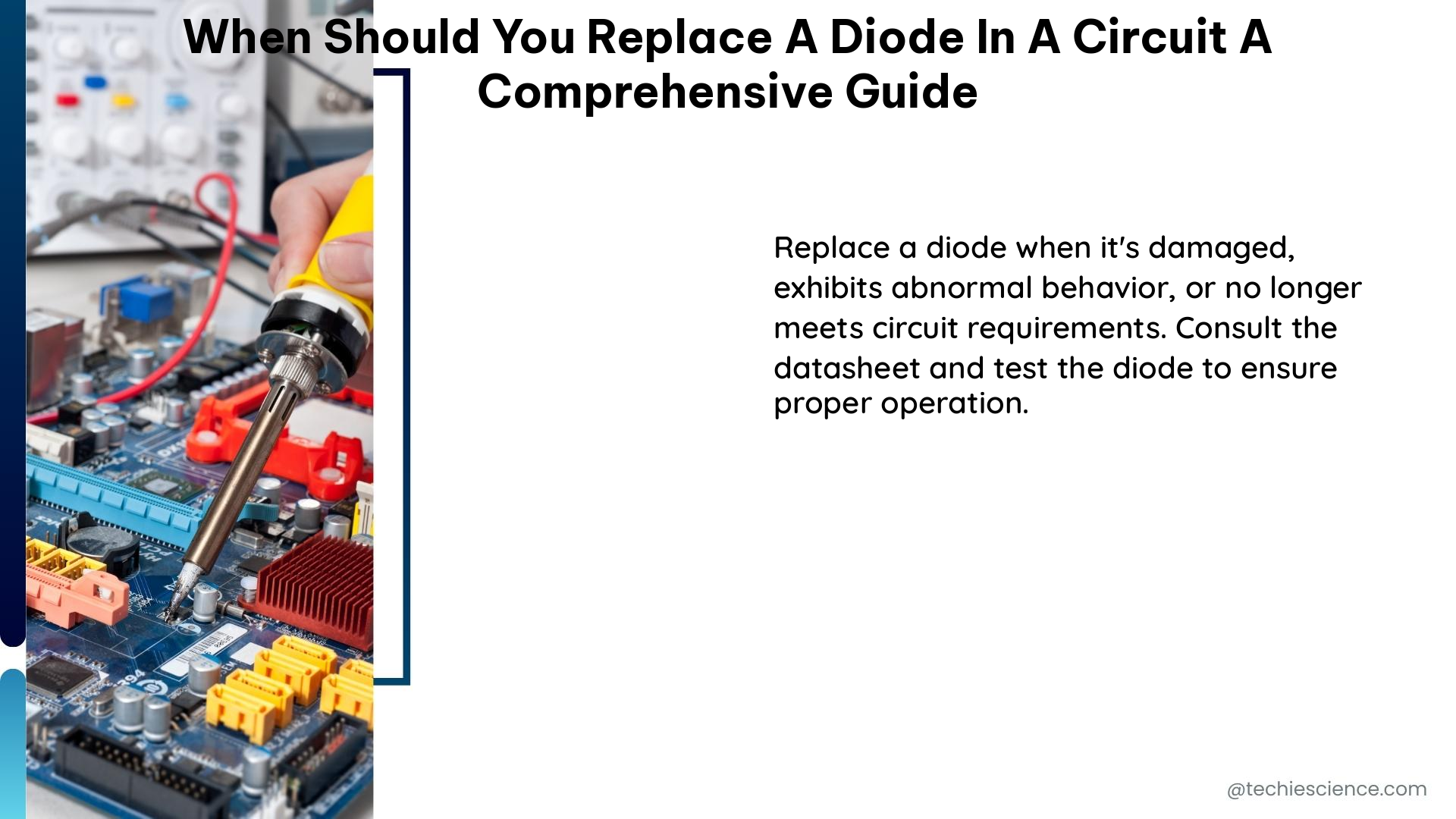Introduction
Diodes are fundamental components in electronic circuits, responsible for allowing current to flow in a single direction. Over time, diodes can deteriorate or fail due to various factors, such as overheating, voltage spikes, or physical damage. This comprehensive guide will delve into the specific circumstances and technical details that warrant the replacement of a diode in a circuit.
When to Replace a Diode

1. Excessive Leakage Current
Diodes are designed to have a negligible amount of current flowing in the reverse direction, known as leakage current. If the diode’s leakage current exceeds the specified limit in the datasheet, it may indicate a failing diode. To measure the leakage current, use a digital multimeter in the diode testing mode. The leakage current should be in the microampere (μA) range or lower, as per the manufacturer’s specifications. If the leakage current is significantly higher, it’s time to replace the diode.
2. High Forward Voltage Drop
As diodes age, their forward voltage drop may increase. The forward voltage drop is the voltage difference between the anode and cathode terminals when the diode is conducting in the forward direction. Measure the forward voltage drop using a digital multimeter in the diode testing mode. Compare the measured value to the specified forward voltage drop in the datasheet. If the voltage drop is substantially higher than the manufacturer’s recommendation, the diode should be replaced.
3. Excessive Reverse Current
A healthy diode should not conduct any significant current in the reverse direction. If the diode is allowing a substantial amount of reverse current to flow, it may be shorted or damaged. Measure the reverse current using a digital multimeter in the ampere (A) mode. If the reverse current is not negligible or zero, as per the datasheet, the diode needs to be replaced.
4. Overheating
Excessive heat can damage the internal structure of a diode, reducing its lifespan. Monitor the diode’s temperature during operation. If the diode becomes too hot to touch or exceeds the maximum operating temperature specified in the datasheet, it’s time to replace the diode. Consider adding a heat sink or improving the cooling mechanism to prevent future overheating issues.
5. Mechanical Damage
Physical damage to the diode, such as cracks in the packaging or visible signs of stress, can affect its performance. Inspect the diode visually for any signs of mechanical damage. If the diode’s body or leads appear compromised, replace the diode to ensure reliable circuit operation.
Technical Specifications and Hands-on Details
When replacing a diode, it’s crucial to consider the following technical specifications and hands-on details to ensure a proper replacement:
-
Power Rating: The replacement diode must have a power rating equal to or greater than the original diode. The power rating is the maximum amount of power the diode can handle without failing. Exceeding the power rating can lead to overheating and premature failure.
-
Package Type: The replacement diode must have a compatible package type and size. Different diode packages have varying mounting and pin configurations, so ensure the new diode fits the existing footprint in the circuit.
-
Reverse Recovery Time: In high-frequency applications, the reverse recovery time of the diode is a critical parameter. Ensure the replacement diode has a similar or faster reverse recovery time to maintain the circuit’s performance.
-
Polarity: Diodes have a specific polarity, with the anode and cathode terminals clearly marked on the diode’s body. When replacing a diode, ensure the new one is installed with the correct polarity, as reversing the polarity can damage the diode and the circuit.
-
Forward Voltage Drop: Match the forward voltage rating of the replacement diode as closely as possible to the original diode. Using a diode with a significantly different forward voltage drop may affect the circuit’s performance and biasing.
-
Reverse Voltage (Zener): For Zener diodes, the reverse voltage rating is the most important parameter. Ensure the replacement Zener diode has the same or a higher reverse voltage rating to maintain the circuit’s functionality.
Conclusion
Replacing a diode in a circuit requires a thorough understanding of the diode’s technical specifications and hands-on attention to detail. By following the guidelines outlined in this comprehensive guide, you can ensure that the replacement diode meets the necessary requirements and functions correctly within the circuit, restoring its reliable operation.
References
- Can you help me find a replacement for this Diode – All About Circuits Forum
- Diodes – Repair Basics – Repair Wiki
- Replacing diode in circuit analysis? – Physics Stack Exchange
- Identifying and replacing diodes?? | Electronics Forums – Maker Pro
- Need help finding replacement for old diode with datasheet FR504 – Reddit

The lambdageeks.com Core SME Team is a group of experienced subject matter experts from diverse scientific and technical fields including Physics, Chemistry, Technology,Electronics & Electrical Engineering, Automotive, Mechanical Engineering. Our team collaborates to create high-quality, well-researched articles on a wide range of science and technology topics for the lambdageeks.com website.
All Our Senior SME are having more than 7 Years of experience in the respective fields . They are either Working Industry Professionals or assocaited With different Universities. Refer Our Authors Page to get to know About our Core SMEs.